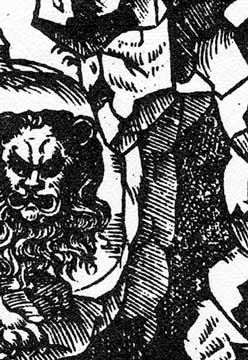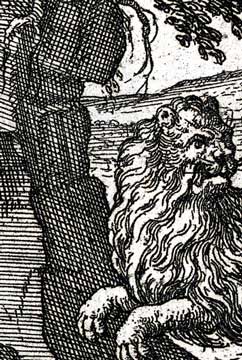Physiologus Images
All of the Physiologus illustrations are copperplate engravings (or possibly etchings; see Voet, v.2, p.863) drawn by Pieter van der Borcht, who did many such illustrations for Plantin's print shop. It is unclear if van der Borcht also did the engraving or etching; his early drawings were usually engraved by specialists (Jean Wiericx and Antoine van Leest, among others), but by 1588 he was doing some of his own engraving and etching, signing at least one of his works "Petrus van der Borcht invenit et fecit" (Delen, p. 88-91). Although van der Borcht sometimes signed his drawings with his initials (PB), no such signature has been found in the Physiologus illustrations.
Delen (p. 91) says of van der Borcht's illustrations for the book: "Les 26 planches de Sancti Epiphanii ad Physiologum, paru chez Plantin en 1588, montrent une autre face du talent de Van der Borcht. Dans de petites compositions carrées, il met en scène des animaux divers, chaque fois devant un fond de paysage, pittoresque et amusant. D'une pointe fine et légère, il gratta ici sur le cuivre des tableautins spirituels qui comptent parmi ses illustrations les plus captivantes." [The 26 illustrations of Sancti Epiphanii ad Physiologum, published by Plantin in 1588, show another face of the talent of Van der Borcht. In small square compositions, he places scenes of various animals, each in front of a landscape background, picturesque and amusing. Engraved here with a fine and light point on copper are the spiritual tableaux which count among his most captivating illustrations.]
Delen and Voet also suggest that van der Borcht might have copied the illustrations from the 1587 edition woodcuts, and a comparison of the two sets of images supports this idea to some extent. However, while many of van der Borcht's illustrations are similar to the woodcuts, and some have almost identical compositions, it is clear that van der Borcht did not merely copy what he saw. Even where the pose of the animals is identical, the van der Borcht illustrations are much more lifelike and detailed. The backgrounds in the woodcuts are for the most part simplistic, while in the copperplate engravings they are fully realized landscapes. Van der Borcht also had a much better grasp of perspective than the woodcut artist; see in particular the illustrations for the caladrius.
Copperplate engravings allow for a much higher level of detail than the woodcuts used for the original 1587 edition, and van der Borcht took full advantage of this. The lines and the cross hatching used for shading are sharp, and the ink has not filled in large black areas, as happened with the woodcuts. This ability to engrave fine lines allowed van der Borcht to produce printed illustrations with great detail, and with variable shading the gives the impression of grays rather than just black and white. Woodcuts usually have coarser carved features, giving the illustrations their characteristic blocky appearance, as shown in the samples below.


Detail of woodcut from the 1587 edition (left) vs.
copperplate engraving from the 1588 edition (right)
The illustrations depict not only the beast, but place the animal against a naturalistic background containing a landscape and often buildings. The animal is usually in the foreground, with the background fading away into the distance to give a remarkable illusion of depth.
Epiphanius Portrait
The portrait of Epiphanius, according to the inscription below the image, was painted by Joannes Adolus Leucosiensis based on an image of Epiphanius from a very ancient model (or icon) found in the monastery of Sula in Constantinople; it is possible that the picture is a true likeness of the saint. Van der Borcht may have done the engraving, though this has not been confirmed.
